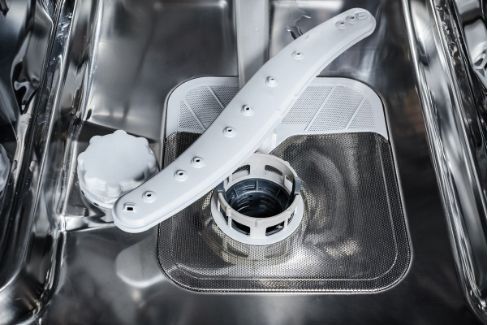Why is My LG Dishwasher Not Cleaning Dishes Properly.
When your dishwasher breaks down, don't let it make you wash dishes by hand. You may be wondering - Why is my LG dishwasher not washing dishes well? There are a few things that it can be caused by. Maybe a damaged or blocked spray arm, the filter needing to be cleaned, or the dishwasher interior is due for a clean. Follow these troubleshooting tips to see if a DIY solution can get your dishwasher back to leaving your dishes sparkling clean.
LG Dishwasher Not Cleaning Dishes? Here is 4 Simple Troubleshooting Techniques:
When it comes to a dishwasher not cleaning dishes properly, it usually can be resolved by changing your care and use. Sometimes there may be a part malfunction but before you go and call an appliance technician to come service it, try these simple DIY solutions.
1. Not Loading Dirty DIshes Properly
One of the most common causes for an LG dishwasher to not clean dishes well is the improper loading of the dirty dishes. Using the racks incorrectly or overcrowding will prevent water and detergent from being able to reach every item. If you find that your dishwasher is not cleaning one rack properly, check to make sure there are no dishes blocking the spray arms.
Here are a few loading tips to improve performance:
- Do not overload: Ensure that there is sufficient space between each dish to ensure that water and detergent can reach each dish.
- Place large items in the bottom rack: Large or tall items should always be put in the bottom rack to ensure that they do not block the spray arms.
- Properly Position Glassware in the Top Rack: Always make sure that all glassware is properly placed between the tines so they do not move during washing.
- Check Spray Arms for Damage or Being Blocked: Check to see if there is any noticeable damage to the spray arms, if not then ensure that each time you run a load that your spray arms are not blocked. Give them a spin before each cycle to make sure they do not hit any dishes.
2. Dishwasher Interior Needs to be Cleaning
Food particles, mildew, and mold can begin to build up in your dishwasher's interior if regular cleanings are not performed. This is due to the dishwasher having a warm and moist environment. This can cause your filters and spray arms to begin to build up with obstructions that do not allow your dishwasher to properly operate. To learn to properly clean your dishwasher, visit here. We recommend monthly cleanings to ensure your dishwasher does not build up with mold or mildew.
Here is how to clean each area of your dishwasher:
Filter:
- Remove the lower rack
- Turn the filter counterclockwise to remove it.
- Rinse both the mesh and main parts of the filter separately under warm water while gently scrubbing them with a soft sponge.
- Replace the mesh filter into the main filter and turn it clockwise to secure it back into place.
Spray Arms:
- Remove the lower and upper spray arms.
- Rinse both arms under warm water and use a non-abrasive sponge to scrub away and mildew or mold.
- Use a straightened paper clip or toothpick to unclog any of the spray holes.
- Replace both arms.
Tub:
- Refer to this page to learn how to properly clean your dishwasher tub.
3. Improper Dishwasher Detergent
It is important to use dishwasher detergent to clean your dishes but the improper use can lead to leaving your dishes clean after a cycle is performed.
To Determine if you are Using the Detergent Properly Use These Tips:
- Add the right amount: If you are not using enough detergent, your dishes will come out dirty. If you are using too much detergent, your dishes will come out with a film over them. To know how much to use, refer to your dishwasher's instructions.
- Use a high-quality detergent: Use a detergent that includes a degreaser and pre-treatment to see if this helps clean your dishes better. Also, always ensure you store your detergent in a cool and dry place and use it within 3 months of purchasing.
- Check the dispenser: your dispenser may not be opening to let out the detergent. After a cycle, check to make sure the detergent is not still in the dispenser. If it is, the dispenser is broken and will need to be replaced.
4. Water Supply Issue:
If your dishes are still coming out dirty, it may mean there is an issue with your water supply. Without your dishwasher having adequate access to hot water, the dishes will not be cleaned properly.
Here is how to check if you have a water issue:
- Check water pressure: First check to see if your kitchen sink has low pressure. If so, you likely have an issue with your water supply. Your dishwasher's inlet valve needs 20-120 PSI of pressure to open and close.
- Check the water inlet valve: If the valve has the proper amount of pressure but still is not opening, you will need to replace the inlet valve by calling in a dishwasher repair technician.
- Check the spray arms for damage: check to see if the spray arms are damaged or if any of the holes are clogged with mildew.
- Check water temperature: Your dishwasher will perform best with temperatures around 120 degrees F. You can run hot water in the sink before running a cycle to ensure your dishwasher has immediate access to hot water.
If none of these tips has got your dishes coming out clean, one of our appliance technicians can service your dishwasher to get it back to cleaning properly.
